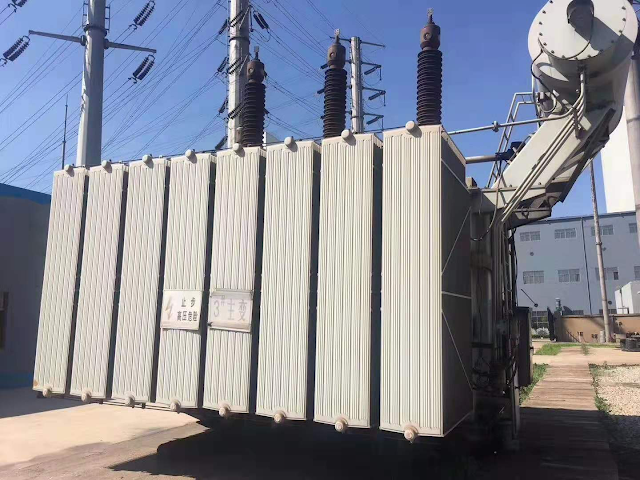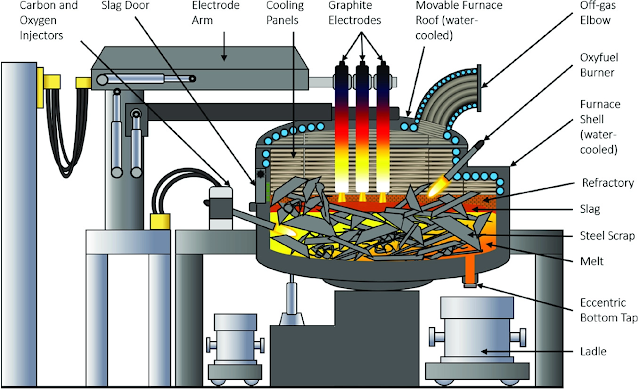Submerged Arc Melting Furnace Principle
A submerged arc melting furnace is also called an electric arc furnace or electric resistance furnace.
Submerged arc melting furnaces are mainly used for reducing smelting ores, carbonaceous reducing agents and solvents, and other raw materials.
It mainly produces ferrosilicon, ferromanganese, ferrochromium, ferrotungsten, silicon-manganese alloy, and other ferroalloys, which are important industrial raw materials in the metallurgical industry and chemical raw materials such as calcium carbide.
The submerged arc melting furnace working principle is to use carbonaceous or magnesia refractory material as furnace lining and use self-cultivation electrodes.
The electrode is inserted into the charge for submerged arc operation, using the energy and current of the arc to pass through the charge, and generating energy due to the resistance of the charge to smelt metal, feeding continuously, intermittently tapping iron slag, an industrial electric furnace with continuous action.
Submerged Arc Melting Furnace Principle & Application
| Category | Main raw materials | Manufactured products | Reflect temperature 0℃ | Power consumption KW*h/t |
Ferroalloy Ferrosilicon Furnace (45%)Ferrosilicate | Scrap iron, coke, ferrosilicon | Ferrosilicon | 1550-1770 | 2100-5500 |
| Ferroalloy Ferrosilicon Furnace (75%)Ferrosilicate | Scrap iron, coke, ferrosilicon | Ferrosilicon | 1550-1770 | 8000-11000 |
| Ferromanganese furnace | Manganese ore, waste iron, coke, lime | Ferromanganese | 1500-1400 | 2400-4000 |
| Ferro-chromium furnace | Chromium ore, silica, coke | Ferric chromium | 1600-1750 | 3200-6000 |
| Ferrous Tungsten Furnace | Tungsten crystal ore, coke | Ferro-Tungsten | 2400-2900 | 3000-5000 |
| Silicon chromium furnace | Ferric chromium, silica, coke | Silicon chromium alloy | 1600-1750 | 3500-6500 |
| Silicon Manganese Furnace | Manganese ore, silica, scrap iron, coke | Silicon-Manganese Alloy | 1350-1400 | 3500-4000 |
| Steel-making electric furnace iron | Ores, coke | Pig iron | 1500-1600 | 1800-2500 |
| Calcium carbide furnace | Limestone, coke | Calcium | 1900-2000 | 1900-3000 |
| Boron Carbide Furnace | Boron oxide, coke | Boron carbide | 1800-2500 | 11000-20000 |
Industrial waste heat refers to a large amount of waste heat generated in industrial production lines of steel, petrochemical, building materials, and non-ferrous metals.
Waste heat power generation technology refers to the technology that uses the high-grade heat of the enterprise to recover and converts it into electricity for the enterprise's own use. my country has always regarded the use of waste heat power generation as one of the important measures to save energy and reduce consumption and achieve cyclic development and has given strong support.
At present, the application field of waste heat power generation technology in my country continues to expand, but in the field of ferroalloy and calcium carbide, flue gas waste heat and other comprehensive waste heat recovery power generation technology are still relatively lacking.
A few days ago, a seminar on waste heat recovery and utilization of submerged arc furnace power generation technology was held in Beijing. Leaders and experts from the National Energy Office, General Iron and Steel Research Institute, National Development and Reform Commission, and various industry associations discussed the development of Xi'an Rich Energy Engineering Technology Co., Ltd., Waste heat power generation technology for ferroalloy, calcium carbide, and other fields.
The waste heat recovery power generation in the fields of ferroalloy and calcium carbide has not been paid much attention because of its large volume and wide range. This technology fills this gap, improves the waste heat recovery rate, and reduces the cost.
At present, energy conservation and emission reduction have become a basic national policy in my country, and the ferroalloy industry is a typical high-energy-consuming industry. The promotion of waste heat recovery power generation technology in this industry is conducive to reducing corporate energy consumption and improving energy utilization efficiency.
Not long ago, the three ministries and commissions of the state issued a document to cancel the preferential electricity price for high-energy-consuming enterprises, and the preferential electricity price for the ferroalloy industry has been canceled since October 20, 2007.
With the increase in electricity cost, the investment recovery period of waste heat recovery power generation projects of ferroalloy enterprises will be further shortened, and this technology will have better development prospects.
Free send inquiries to stella@hanrm.com or inquiry99@hanmetallurgy.com if any needs.
Email: stella@hanrm.com Or stellarollingmill@gmail.com inquiry99@hanmetallurgy.com
Whatsapp/Wechat:+8615877652925
Website: https://www.hanmetallurgy.com/





.jpg)







